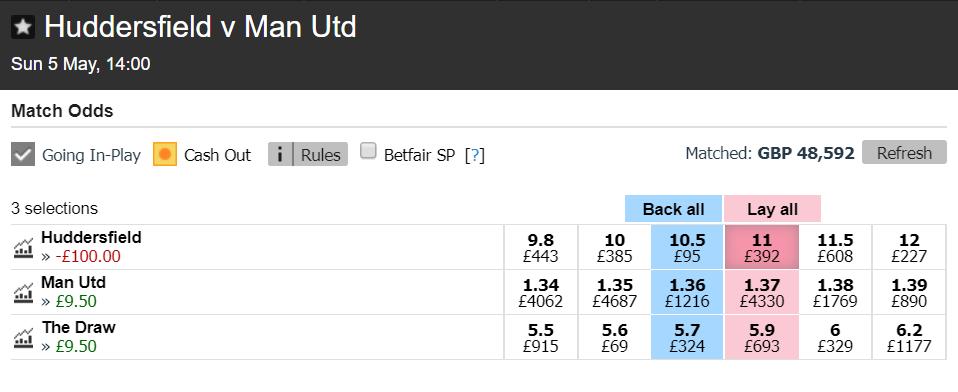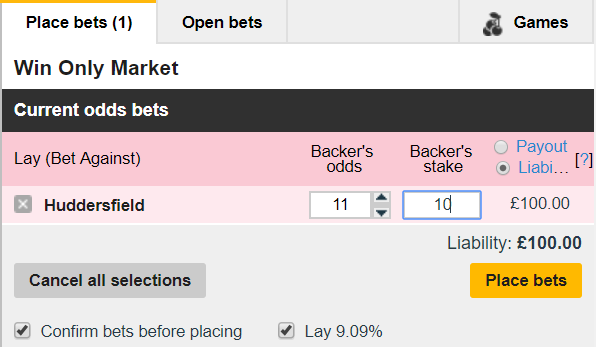- A lay bet enables a bettor to assume the role of the bookmaker, betting against a specific outcome.

A lay bet enables a bettor to acts as the bookmaker by betting against a particular outcome happening
What Is a Lay Bet?
A lay bet flips the typical betting dynamic, with the bettor assuming the role of the bookmaker, betting against a specific outcome. Rather than backing a particular team, player, or horse to win, the bettor is essentially betting that the outcome will not happen.
For example, in a football match between Manchester United and Liverpool, a traditional bettor might bet on Manchester United to win the match. A lay bettor, on the other hand, could bet against Manchester United winning the match, effectively betting on Liverpool or a draw.
When you place a lay bet, you emulate a bookmaker. This means that if the outcome you bet against happens, you automatically pay out the winnings to the opposing bettor. This potential payout represents the liability of a lay bet.
On the other hand, if the outcome you bet against does not happen, you get to keep the stake that was placed by the opposing bettor, minus any commission that may be charged by the platform or betting exchange you used to place the bet.
It’s important to note that lay betting is only available through a betting exchange rather than a conventional bookmaker.
The Appeal of Lay Betting
The main advantages of lay betting are:
- Increased Flexibility: Lay betting lets you bet on an event’s outcome without needing to back a specific selection, offering more flexibility in your betting approach.
- Better Odds: When laying a bet, you often get better odds compared to backing a selection. This is because you act as the bookmaker, setting your own price.
- Hedging Opportunities: Lay betting provides chances to hedge your bets. For instance, you can place a lay bet to cover your initial bet, reducing your risk and ensuring you won’t lose money if the outcome goes against your prediction.
- No Liability Limitations: Apart from liquidity, there are no restrictions on your potential winnings. Since you’re not bound by traditional bookmakers’ maximum payout limits, your earning potential is unrestricted.
Where to Place Lay Bets
You can only use Betting Exchanges to place lay bets. I recommend the following sites for lay betting:
#ad. 18+, GambleAware.org, T&Cs Apply
#ad. 18+, GambleAware.org, T&Cs Apply
#ad. 18+, GambleAware.org, T&Cs Apply
The Basics of Lay Betting
For many novice punters, lay bets might seem daunting at first glance. However, the process of placing them and calculating potential payouts is straightforward. Let me walk you through it using Betfair, the leading betting exchange.
Let’s say I want to place a £10 lay stake on Huddersfield in an upcoming fixture against Manchester United.
On Betfair, lay prices are always displayed in pink (and typically on most exchanges). They are always higher than the blue “back” odds. Currently, the best (lowest) lay odds for Huddersfield are 11.0, with up to £392 available at that price.

To place the bet, simply click on the pink lay odds, which will prompt you to enter your stake.

It’s important to note that the liability for this £10 lay bet is £100. This calculation follows the formula of £10 x (11.0 – 1) = £100. Your betting account must have enough funds to cover this liability in the event that Huddersfield wins the match.
Your stake is then matched with other Betfair users who are looking to back Huddersfield at that price, following a first-come, first-served basis. This same principle applies to other peer-to-peer betting platforms and apps.
Mastering lay bets is crucial if you aim to generate risk-free profits from Matched Betting.
Liability Explained
When you place a lay bet, your stake gets matched with other traders on the exchange who want to “Back” the same selection to win. This means you take on a risk, referred to as the “liability,” which is the potential amount you might have to pay out to those who backed against your stake. The liability of a lay bet hinges on both the stake and the agreed odds with the punter.
Let’s consider an example: Imagine a trader puts down a £10 Back stake at decimal odds of 4.0 for Everton to beat Chelsea in a Premier League match.
For simplicity, let’s say the entire £10 stake of the Backer gets matched with one trader betting against Everton, who we’ll call the “Layer.”
Now, there are three possible outcomes:
- Everton wins: The Layer loses and has to pay out to the Backer.
- Draw: The Layer wins and retains the Backer’s £10 stake.
- Chelsea wins: The Layer wins and retains the Backer’s £10 stake.
So, in 2 out of 3 outcomes, the Layer wins the £10 stake. But how much does the Layer stand to lose if Everton wins? What’s the liability?
To work this out, you can use a simple formula:
Stake × (DecimalOdds − 1)
You subtract 1 from the odds because you’re only obligated to pay out the winning punters their profits, not their stake as well.
In our example, it’s: £10 × (4.0 – 1) = £30. Thus, the Layer faces a potential loss of £30 in this exchange, known as the liability or risk of their lay bet.
Instead of manually calculating your lay bets, I suggest using an online Lay calculator for convenience.
What to Look for in a Lay Bet
The single most important thing to consider about a lay bet is your liability (risk). So how do you limit your liability? Here’s my suggestions:
Seek Low Value Odds
When you’re backing, targeting the highest odds is pivotal to maximise value and diminish the bookies’ edge. Conversely, when you’re in the role of the layer (or the Bookie), opt for the lowest possible odds on your lay bets.
Scout around different betting exchanges for the best (lowest) lay odds. Additionally, consider requesting (queuing) lower prices on the betting exchange to reduce your liability—although there’s no guarantee of getting matched if your odds are too low. Nonetheless, making price requests helps reduce the payout amount to Backers in case of a win.
Lay When Odds Offer Value
When placing a lay bet, target lay odds that suggest the outcome is more probable than it actually is. Essentially, look for odds that are lower than they should be.
For instance, if you believe the true odds of an outcome are 3.0 (implying a 33.33% chance of occurring) and the lay price in the market is 2.5 (implying a 40% chance), then it’s a favourable lay bet. This is because the 2.5 price offers great value for layers but poor value for Backers.
Such ‘value lay bet’ scenarios often arise when a sports event outcome is overhyped. For instance, biases or favouritism toward a football team can drive down prices.
You can leverage your own statistical analysis to formulate your decisions. Learn about compiling your own odds.
Consider Bookmakers' Odds
Remember, Bookmakers profit from laying bets. Hence, their odds tend to be underpriced for Backers. Therefore, aim to lay bets at odds close to those offered by Bookies.
However, always rely on your own analysis and expertise in a sport to determine your target lay prices. Contrary to popular belief, Bookmakers aren’t infallible (see sports betting myths).
Lay Bet Summary
Keep in mind that with any lay bet, the layer faces two potential outcomes:
- Winning the amount laid, and no more (as in the example above, where it’s £10).
- Losing the liability, which can exceed the stake laid, especially when the agreed odds are above 2.0.
The laying process mirrors that of Bookmakers who offer odds to the public.
Additionally, it’s important to acknowledge that regardless of the odds you lay at—no matter how high—there’s always a possibility that the outcome will win, and you’ll be obligated to pay out. Therefore, it’s prudent to limit your risk and thoroughly test your strategy before engaging in high-risk bets.
More Bet Types
- Decimal Odds | What Are Decimal Odds? How Do They Work? - July 7, 2025
- June 2025|Top Football Tipsters Of The Month - July 7, 2025
- June 2025 | Top Horse Racing Tipsters Of The Month - July 7, 2025













